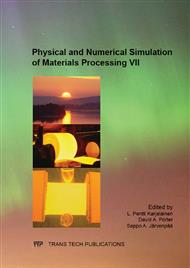p.189
p.194
p.210
p.218
p.224
p.230
p.236
p.242
p.248
Numerical Simulation of Casting Thermal Stress and Deformation Based on Finite Difference Method
Abstract:
Thermal stress simulation is an important part in the numerical simulation of casting process. It provides engineers with insights into the evolution of displacement, strain and stress of castings in the solidification process. With thermal stress simulation, some defects of casting, i.e. hot tearing, cold cracking and large deformation can be predicted and the engineers are instructed to optimize and improve the casting process. Based on the finite difference method (FDM), this paper presents an integrated numerical method to simulate the thermal stress and deformation of casting in the solidification process. Practical examples show that the method is capable to predict stress distribution and deformation as well as the defects in the experiment.
Info:
Periodical:
Pages:
224-229
Citation:
Online since:
July 2013
Authors:
Price:
Сopyright:
© 2013 Trans Tech Publications Ltd. All Rights Reserved
Share:
Citation:


